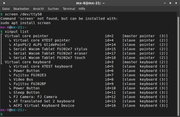Code: Select all
Snapshot created on: 20250704_2122
System:
Kernel: 6.1.0-37-amd64 [6.1.140-1] arch: x86_64 bits: 64 compiler: gcc v: 12.2.0
parameters: BOOT_IMAGE=/boot/vmlinuz-6.1.0-37-amd64 root=UUID=<filter> ro quiet splash
Desktop: KDE Plasma v: 5.27.5 wm: kwin_x11 vt: 7 dm: SDDM Distro: MX-23.6.1_KDE_x64 Libretto
May 18 2025 base: Debian GNU/Linux 12 (bookworm)
Machine:
Type: Laptop System: FUJITSU SIEMENS product: LifeBook T4310 v: 10601155984
serial: <superuser required> Chassis: type: 10 v: LifeBook T4310 serial: <superuser required>
Mobo: FUJITSU model: FJNB206 v: K5 serial: <superuser required> BIOS: FUJITSU // Phoenix
v: Version 1.05 date: 09/30/2009
Battery:
ID-1: CMB2 charge: 39.4 Wh (96.1%) condition: 41.0/41.0 Wh (100.0%) volts: 12.3 min: 10.8
model: Fujitsu CP384590-01 type: Li-ion serial: <filter> status: not charging
CPU:
Info: model: Intel Core2 Duo T6570 bits: 64 type: MCP arch: Penryn level: v1 built: 2008
process: Intel 45nm family: 6 model-id: 0x17 (23) stepping: 0xA (10) microcode: 0xA0B
Topology: cpus: 1x cores: 2 smt: <unsupported> cache: L1: 128 KiB desc: d-2x32 KiB; i-2x32 KiB
L2: 2 MiB desc: 1x2 MiB
Speed (MHz): avg: 1197 min/max: 1200/2101 boost: enabled scaling: driver: acpi-cpufreq
governor: ondemand cores: 1: 1197 2: 1197 bogomips: 8379
Flags: ht lm nx pae sse sse2 sse3 sse4_1 ssse3 vmx
Vulnerabilities:
Type: gather_data_sampling status: Not affected
Type: indirect_target_selection status: Not affected
Type: itlb_multihit status: KVM: VMX disabled
Type: l1tf mitigation: PTE Inversion; VMX: conditional cache flushes, SMT disabled
Type: mds status: Vulnerable: Clear CPU buffers attempted, no microcode; SMT disabled
Type: meltdown mitigation: PTI
Type: mmio_stale_data status: Unknown: No mitigations
Type: reg_file_data_sampling status: Not affected
Type: retbleed status: Not affected
Type: spec_rstack_overflow status: Not affected
Type: spec_store_bypass status: Vulnerable
Type: spectre_v1 mitigation: usercopy/swapgs barriers and __user pointer sanitization
Type: spectre_v2 mitigation: Retpolines; STIBP: disabled; RSB filling; PBRSB-eIBRS: Not
affected; BHI: Not affected
Type: srbds status: Not affected
Type: tsx_async_abort status: Not affected
Graphics:
Device-1: Intel Mobile 4 Series Integrated Graphics vendor: Fujitsu driver: i915 v: kernel
arch: Gen-5 process: Intel 45nm built: 2008 ports: active: LVDS-1 empty: DP-1, DP-2, HDMI-A-1,
VGA-1 bus-ID: 00:02.0 chip-ID: 8086:2a42 class-ID: 0300
Device-2: Chicony FJ Camera type: USB driver: uvcvideo bus-ID: 4-4:4 chip-ID: 04f2:b186
class-ID: 0e02
Display: x11 server: X.Org v: 1.21.1.7 with: Xwayland v: 22.1.9 compositor: kwin_x11 driver: X:
loaded: intel dri: crocus gpu: i915 display-ID: :0 screens: 1
Screen-1: 0 s-res: 1280x800 s-dpi: 96 s-size: 338x211mm (13.31x8.31") s-diag: 398mm (15.69")
Monitor-1: LVDS-1 mapped: LVDS1 res: 1280x800 hz: 60 size: N/A modes: 1280x800
API: OpenGL v: 2.1 Mesa 24.2.8-1mx23ahs renderer: Mesa Mobile Intel GM45 Express (CTG)
direct-render: Yes
Audio:
Device-1: Intel 82801I HD Audio vendor: Fujitsu driver: snd_hda_intel v: kernel bus-ID: 00:1b.0
chip-ID: 8086:293e class-ID: 0403
API: ALSA v: k6.1.0-37-amd64 status: kernel-api tools: alsamixer,amixer
Server-1: PipeWire v: 1.0.0 status: active with: 1: pipewire-pulse status: active
2: wireplumber status: active 3: pipewire-alsa type: plugin 4: pw-jack type: plugin
tools: pactl,pw-cat,pw-cli,wpctl
Network:
Device-1: Broadcom NetLink BCM57780 Gigabit Ethernet PCIe vendor: Fujitsu driver: tg3 v: kernel
pcie: gen: 1 speed: 2.5 GT/s lanes: 1 port: N/A bus-ID: 08:00.0 chip-ID: 14e4:1692 class-ID: 0200
IF: eth0 state: down mac: <filter>
Device-2: Qualcomm Atheros AR928X Wireless Network Adapter vendor: Fujitsu driver: ath9k
v: kernel modules: wl pcie: gen: 1 speed: 2.5 GT/s lanes: 1 bus-ID: 18:00.0 chip-ID: 168c:002a
class-ID: 0280
IF: wlan0 state: up mac: <filter>
Bluetooth:
Device-1: Askey [hex] type: USB driver: btusb v: 0.8 bus-ID: 6-2:3 chip-ID: 1690:0741
class-ID: e001
Report: hciconfig ID: hci0 rfk-id: 3 state: down bt-service: N/A rfk-block: hardware: no
software: yes address: <filter>
Info: acl-mtu: 310:10 sco-mtu: 64:8 link-policy: rswitch hold sniff park
link-mode: peripheral accept
Drives:
Local Storage: total: 232.89 GiB used: 6.21 GiB (2.7%)
SMART Message: Unable to run smartctl. Root privileges required.
ID-1: /dev/sda maj-min: 8:0 vendor: Crucial model: CT250BX100SSD1 size: 232.89 GiB block-size:
physical: 512 B logical: 512 B speed: 3.0 Gb/s type: SSD serial: <filter> rev: MU01 scheme: MBR
Partition:
ID-1: / raw-size: 39.06 GiB size: 39.06 GiB (100.00%) used: 5.73 GiB (14.7%) fs: btrfs
dev: /dev/sda1 maj-min: 8:1
ID-2: /home raw-size: 29.3 GiB size: 29.3 GiB (100.00%) used: 490.4 MiB (1.6%) fs: btrfs
dev: /dev/sda2 maj-min: 8:2
Swap:
Kernel: swappiness: 15 (default 60) cache-pressure: 100 (default)
ID-1: swap-1 type: partition size: 4.88 GiB used: 1.8 MiB (0.0%) priority: -2 dev: /dev/sda3
maj-min: 8:3
Sensors:
System Temperatures: cpu: 43.0 C mobo: N/A
Fan Speeds (RPM): N/A
Repos:
Packages: pm: dpkg pkgs: 2541 libs: 1361 tools: apt,apt-get,aptitude,nala pm: rpm pkgs: 0
pm: flatpak pkgs: 0
No active apt repos in: /etc/apt/sources.list
Active apt repos in: /etc/apt/sources.list.d/debian-stable-updates.list
1: deb http://deb.debian.org/debian bookworm-updates main contrib non-free non-free-firmware
Active apt repos in: /etc/apt/sources.list.d/debian.list
1: deb http://deb.debian.org/debian bookworm main contrib non-free non-free-firmware
2: deb http://security.debian.org/debian-security bookworm-security main contrib non-free non-free-firmware
Active apt repos in: /etc/apt/sources.list.d/mx.list
1: deb https://linux.rub.de/mxlinux/packages/mx/repo/ bookworm main non-free
2: deb https://linux.rub.de/mxlinux/packages/mx/repo/ bookworm ahs
Info:
Processes: 262 Uptime: 7h 34m wakeups: 4 Memory: 3.76 GiB used: 2.22 GiB (59.0%) Init: SysVinit
v: 3.06 runlevel: 5 default: graphical tool: systemctl Compilers: gcc: 12.2.0 alt: 12
Client: shell wrapper v: 5.2.15-release inxi: 3.3.26
Boot Mode: BIOS (legacy, CSM, MBR)

